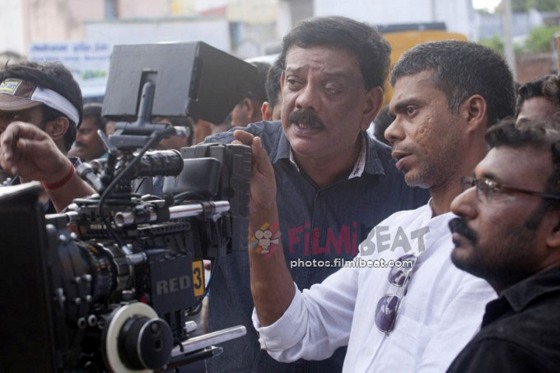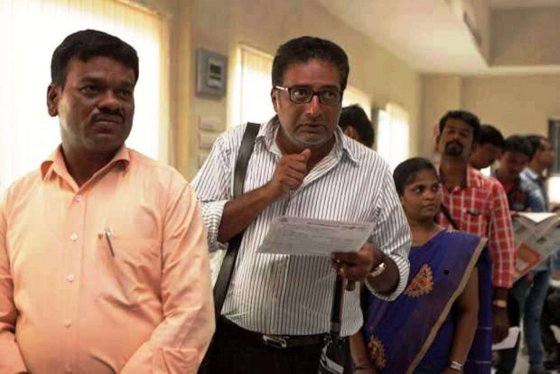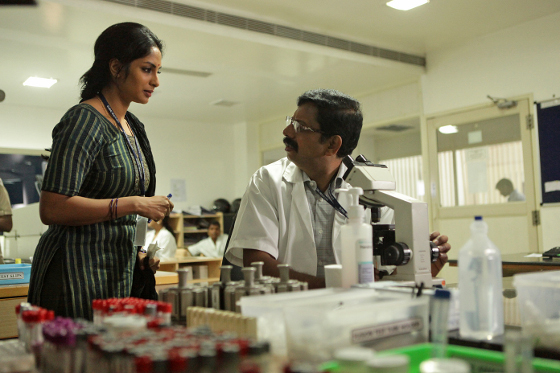A feature film with a strong social agenda can sometimes be boring, or alternately, appear to be waving a flag like a promotional film to promote an agenda. But a fresh breeze has come in with Priyadarshan’s Tamil film Sila Samayangalil (2016) that translates to “Sometimes” in English which is a moving human document on how just the fear of being HIV-positive can play havoc with the lives of ordinary people coming from different walks of life. This film has already won three awards at the Jaipur International Film Festival, apart from the Special Jury Award at the Chennai International Film Festival. It was also selected by the Golden Globes for a premiere in Los Angeles.
Priyadarshan is one of the well-known directors of Malayalam, Tamil, Telugu, and Hindi cinema. He has directed 90 films over a span of three decades but is known mainly for his commitment to the box office. Priyadarshan was bestowed the Padma Shri in 2012 for his contribution in the field of Arts.

Priyadarshan, director of the movie Sila Samayangalil. Pic: Kolkata International Film Festival 2016
Priyadarshan was one of the first directors in India to introduce rich color grading, clear sound and quality dubbing through his early Malayalam films. Among his Hindi films, one may recall Viraasat (1997), a mainstream Hindi film that showcased actors Anil Kapoor, Tabu and Amrish Puri differently. Films with a ‘message’ have not really been his credo. In this scenario, with hilarious interludes like Hera Pheri (2000), Sila Samayangalil throws up a wonderful surprise not only in terms of its narrative line but also in terms of the unusual cinematic treatment Priyadarshan has vested it with.
He had announced earlier that he intended to make at least three films that traversed the path of socially conscious films not targeted at the box office. The first was Kanchivaram which bagged top honours at the 55th National Film Awards in 2007 for Best Feature Film and Best Actor for main protagonist Prakash Raj. This film revolved around a silk weaver who is exploited and imprisoned in severely impoverished situations and how he gathers fellow silk-weavers around him to press their demands and refuses to be exploited. Sila Samayangalil is the second non-commercial film by Priyadarshan. His last socially conscious film will be on female foeticide.
Talking about his motivation, this soft-spoken, very grounded director says, “There are films you make because you are passionate. Then there are films you make because you are greedy. Most of my films belong to the latter category. But this film is to feed the filmmaker and not his pocket.”
Sila Samayangalil underscores the pertinent fact that AIDS can happen to anyone and everyone and may not necessarily result from sexual promiscuity as we commonly believe. The entire film is placed within the interiors of the waiting lounge of what appears to be a well-appointed pathological clinic in a posh hospital in Bengaluru. Yet, it does not make the audience feel claustrophobic watching a “sad” film within such closed surroundings for two hours.
“AIDS is an uninteresting subject,” says Priyadarshan. “All one can do with it is make a documentary which few would be prepared to watch as very few documentaries are available for public exhibition and there is no entertainment value in them. The challenge for me was to turn a dry subject into a thriller with a bit of comedy thrown in for relief. A thriller gets through to the people which, in turn, raises awareness. It is not just about sending a message which can be done through SMS messages or across social networking sites,” he adds.
A movie with many messages
Eight men and women of different ages, from different backgrounds and professions are thrown together to get the enzyme-linked immunosorbent assay (ELISA) Test done to find out whether they are HIV-positive or not.
The ELISA and Western blot tests are recommended if you have been exposed to HIV or are at risk of contracting HIV. The camera ambles across different areas and spaces of the waiting lounge, pausing for a moment or some more, perhaps, to catch a young man using his laptop to escape the suspense of waiting for the results. The young lady across the counter seems under severe stress for personal reasons and does not know how to deal with this anxious group. None of them know whether they are HIV-positive or not and the agony quotient among them escalates every minute reaching out to the film audience waiting for the results as much as the characters in the film are. The element of constant suspense gives this film an added dimension.
The opening frames are captured in overhead shots of a crowded railway station where a local train has just arrived and the commuters have detrained. We see a young woman talking to her mother on her cell. The mother asks her to bring Rs 5000 urgently to clear the back rent due to the landlord. Soon after she steps in her cabin and we discover that she is a clerk in the hospital. She seats herself in the cabin behind the counter and looks across at the patients waiting for the results. She looks flustered as her mother calls her up again and again and the patients approach her through the small opening at the glass counter to ask about the results. She asks them to wait.

A still from Sila Samayangalil. Pic: Kolkata International Film Festival 2016
The patients have come because they are afraid either of some symptoms they have been observing, or, because of some secret in their past they have not shared with their families. The entire film is a microcosm of the world out there, captured in a day from morning till evening seen from the perspectives not only of the men and women waiting with bated breath for the results to come, but also from the perspective of a lady laboratory clerk who is to hand out the test results to the waiting candidates. The director is in control, letting the audience look at these distressed lives through his eyes and theirs.
Each patient has a back story cinematographed in black-and-white. There is less recreation of the past through flashbacks and flashes into the past are more like confessions they make as they begin to bond, smoothing away the rough and tough edges of their individualities. One of them, ACP Karuna, is a pot-bellied corrupt ACP, ill-mannered and arrogant to begin with but sobers down as the skeletons from his cupboard begin tumbling out. This slow but steady metamorphosis affects all the waiting patients one by one, pointing out how the fear of death can level out all differences between and among people. Priyadarshan states that he did not repeat a single shot in the film and this comes across for one who watches the film closely.
One is a lawyer who was given nine bottles of blood after he was shot back at by a prisoner trying to escape from jail and he had shot at the prisoner to stop his escape. Since then, he had begun to lose weight and his doctor advised him to go in for the ELISA test. One is a truck driver who suspects that he has contracted AIDS because he often visited prostitutes along the highways and expressways to stop for dinner or the night. Sheela, an only child, was raped and suspects that she contacted the virus from this rape and could not share this with her parents. Another young man is a drug addict and thinks he got it from the polluted syringe his drug-user friend had given him. An old man has come to get tested because he was suffering from blurred vision and memory loss from an accident. A contractor has come to get tested too and he recognizes the corrupt policeman who pressed him for bribes so refuses to recognize him.
The film, without making an issue of this, or raising slogans or its voice, points out how an ELISA test should normally take not more than 20 minutes but in this film, the results begin to come out only at 5 PM, by then the eight men and women are at the end of their tether. How an honest worker can be forced into corrupt ways to find an immediate solution to financial problems through easy bribes is also brought into focus.

A scene from the movie Sila Samayangalil. Pic: Kolkata International Film Festival 2016
Sila Samayangalil holds a many-sided mirror to contemporary society that reflects how the people living in it change when death stares them in the face and when they are further victimised by the lethargic ways of bureaucracy on the one hand and corruption on the other. The film has some very good actors like Prakash Raj, Ashok Selvan and Shriya Saran.
Reports say that Prakash Raj did not take a single paisa for his role in this film. The other actors perform with marvellous conviction, as if they are drawn from real life and are not actors. The waiting patients are reduced to token numbers, as each one is called out by the token number he/she has been given and not his/her name. The tragedy of suddenly becoming anonymous comes across with biting sarcasm, a feature that is gently and generously scattered right through the film adding one more dimension to this celluloid statement on AIDS which will go down well with audiences across the map.
Sameer Thahir’s camera is low-key, vacillating at times between grays and light blues within the waiting lounge and black-and-white for the narrated flashbacks and closing in on the faces of the characters that slowly get drenched in anxiety. Bina Paul’s editing maintains a seamless pace within a slow rhythm to match the sombre mood of the film. The editing often cuts to close in on the small, cylindrical bottles with their red caps with blood in them placed in a collective holder, bottles being uncapped, syringes being pushed and pulled, cutting to a computer with keys being pressed and the completely insulated medical staff in charge of the tests sometimes glancing back at the girl at the counter. Every such cut is designed both to sustain the level of suspense and to lead up to the final drama.

Sabu Cyril’s set design is no-nonsense and plain that strips any hint of glamour from a film that glamour and colour would have ruined beyond repair. Ilaiyaraaja’s musical score is entirely in pace with the film’s temperament, dotted often by the ingenuous sound design by M. R. Rajakrishnan. Objects and instruments of everyday use, such as an umbrella the old man carries, or the laptop the young man sticks to, or, the cell-phone the young girl is talking into, the small blood samples the lab technician is toying around with, the single black pawn from the chess falling with sounds of it rolling across the floor of the waiting room, adds another dimension to the story not to forget the large clock on the wall that reminds all of us that we all live on borrowed time. Ilayaraja’s music has some old film songs dotting the soundtrack perhaps to juxtapose the normalcy of life beyond the waiting room with the rising anxiety inside it. But for the main, the music remains very low key and subtle and does not dominate the scenario, the story or the characters.
“Commercial films have a way of straitjacketing you because you are constantly trying to speed up every moment, over-explaining every little thing. Art films give you freedom…I did not think about what people would think when I made Kanchivaram and Sila Samayangalil,” says Priyadarshan. Sila Samayangalil is produced jointly by Amala Paul’s Think Big Studios and Prabhu Deva Studios.
Indian cinema has so far, tried to avoid dealing with AIDS directly. A few exceptions in Bollywood are – My Brother Nikhil (2004) and Phir Milenge, (2005), said to be ‘inspired’ by the Hollywood film Philadelphia (1993). There have been a few others that sank before the audience even heard of them. In this ambience where AIDS has been treated gingerly, comes Priyadarshan’s Sila Samayangalil, which places AIDS against a broader, socio-political canvas aimed at making the audience identify with the scare that AIDS instils in ordinary men and women more than the presence/absence of HIV itself.
